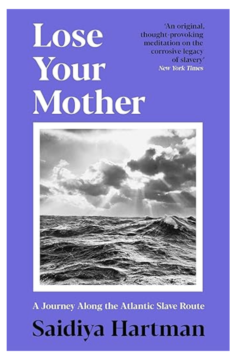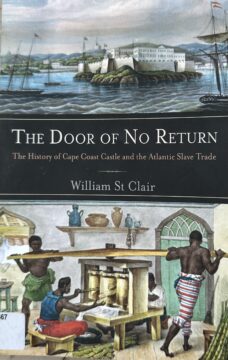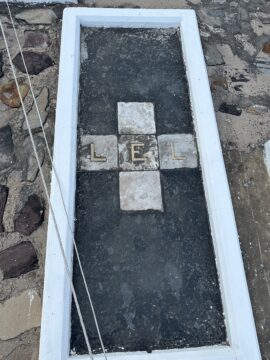by Rafaël Newman

Saidiya Hartman made her second trip to Ghana in 1997. She had visited the country briefly the year before, as a tourist, but now, having recently completed a doctorate at Yale and published her first book, she was in Ghana as a Fulbright Scholar searching for historical evidence of local resistance to slave raids. She was also, as a Black American, in quest of a connection with her putative ancestral homeland, and hoping to flesh out her work, both scholarly and personal, in the archives, where she had had a fleeting glimpse of her heritage as the descendant of people kidnapped and indentured, as “chattel,” to slave-owners in the New World.
I chose Ghana because it possessed more dungeons, prisons, and slave pens than any other country in West Africa—tight dark cells buried underground, barred cavernous cells, narrow cylindrical cells, dank cells, makeshift cells. In the rush for gold and slaves that began at the end of the fifteenth century, the Portuguese, English, Dutch, French, Danes, Swedes, and Brandenburgers (Germans) built fifty permanent outposts, forts, and castles designed to ensure their place in the Africa trade. In these dungeons, storerooms, and holding cells, slaves were imprisoned until transported across the Atlantic.
Until it wrested its independence from the British in 1957 Ghana was known as Gold Coast, a name that commemorates the commodity that had first brought Europeans to the region in the 1400s, but which belies the more nefarious commerce that kept them there four centuries long. The country we now call Ghana, named by its first president, Kwame Nkrumah, for a revered but defunct medieval kingdom to its north, was until the 1800s the crossroads for several slave routes from the inland to the sea, and to passage, for those kidnapped, across the Atlantic to a life of servitude. Ghana’s coastline is studded with forts and castles—command centers and entrepôts for the trade in people enslaved from throughout west central Africa: effectively concentration camps—like a string of poisoned beads.
 Hartman’s record of her second sojourn in Ghana, Lose Your Mother: A Journey Along the Atlantic Slave Route (2007), is a harrowing account of the extreme violence and actuarial cynicism by which the slave trade was pursued, as well as of the dashed illusions of a modern young American expecting to be welcomed back into an imagined community in what may have been her ancestors’ country, but instead encountering a mixture of derision and denial from the contemporary inhabitants of that space. She was repeatedly cast by the local people she encountered in Ghana as an obruni, or “stranger,” a word Hartman came to associate with the alienated status of the enslaved. Indeed, in some cases her desire for a connection with Ghana through phantom kinship, so like the painfully naïve attempts of American-born descendants of other ethnic groups to forge ties with their Irish or Italian “motherland,” is met with frank rejection: why would anyone wish to commemorate their heritage as the descendant of the enslaved? The modern American celebration of victimhood makes no sense to a striving, thriving, developing country, keen to join the ranks of the industrialized world. Furthermore, in western Africa today, one is as likely to meet the descendants of those who enslaved others, as of those who were enslaved: a shameful complicity best left undiscussed. And finally, most painfully, Hartman comes to understand that the “original” homeland she has been searching for bears a greater resemblance to the very United States she and so many others of her generation condemn, than to their dream of ethnic renewal and spiritual redemption:
Hartman’s record of her second sojourn in Ghana, Lose Your Mother: A Journey Along the Atlantic Slave Route (2007), is a harrowing account of the extreme violence and actuarial cynicism by which the slave trade was pursued, as well as of the dashed illusions of a modern young American expecting to be welcomed back into an imagined community in what may have been her ancestors’ country, but instead encountering a mixture of derision and denial from the contemporary inhabitants of that space. She was repeatedly cast by the local people she encountered in Ghana as an obruni, or “stranger,” a word Hartman came to associate with the alienated status of the enslaved. Indeed, in some cases her desire for a connection with Ghana through phantom kinship, so like the painfully naïve attempts of American-born descendants of other ethnic groups to forge ties with their Irish or Italian “motherland,” is met with frank rejection: why would anyone wish to commemorate their heritage as the descendant of the enslaved? The modern American celebration of victimhood makes no sense to a striving, thriving, developing country, keen to join the ranks of the industrialized world. Furthermore, in western Africa today, one is as likely to meet the descendants of those who enslaved others, as of those who were enslaved: a shameful complicity best left undiscussed. And finally, most painfully, Hartman comes to understand that the “original” homeland she has been searching for bears a greater resemblance to the very United States she and so many others of her generation condemn, than to their dream of ethnic renewal and spiritual redemption:
It was ironic that the kind of African Americans who would fit best in Ghana were the ones least attracted to Africa. The straightened-hair, prim, Bible thumping, flag-waving black Christian conservatives would be much more at home in Ghana than the frayed band of dreadlocked and nappy-headed radicals who inundated the place. Evangelicals were welcome; protesters need not apply. Most Ghanaians were Christian, respectful of hierarchy and authority to a fault, straitlaced, and wary of foreigners in need of love. The country that most of us had come running from was the one of which they dreamed. They would have traded places with us in the blink of an eye.
As she retreats from the bruising world of Accra for the villages of slave-raid resisters in the north and the grim fortifications to the west, Hartman is haunted by the silence she is encountering, both from her contemporaries in Ghana and in the historical record. “No one imprisoned in the dungeon of Cape Coast Castle had ever described it. There was no record left behind by the captives who entered and exited the underground. Not a single account. All the journals, reports, letters, and trade documents belonged to merchants and company men.” She is particularly disturbed by the absence of testimony by enslaved women and girls, even in contexts putatively sympathetic to the cause of the kidnapped. Such as at the celebrated trial of the captain of the Recovery in 1792, on charges brought by the abolitionist William Wilberforce, for the torture and murder of a young enslaved woman: perhaps because she had declined to dance for the captain, or had resisted rape at his hands, or was simply suspected of attempting suicide by refusing nourishment. “Was the scene too horrible to describe or too painful or both,” Hartman wonders, in a chapter of Lose Your Mother entitled “The Dead Book,” after the log kept by captains of human cargo lost on the voyage. Hartman then goes on, after imagining the scene of the young woman’s torment from the perspectives of her various tormentors, to supply their long-perished victim with an imagined consciousness in the throes of her agony, and thus to figuratively resurrect her for posterity: while at the same time, as Hartman later reflects, definitively consigning her to her watery grave with the same tool—written language—by which she had been namelessly, facelessly inscribed in the Dead Book.
Hartman has since developed a larger-than-life media presence unusual for an American academic. In addition to publishing other innovative work since Lose Your Mother, including Wayward Lives, Beautiful Experiments: Intimate Histories of Riotous Black Girls, Troublesome Women, and Queer Radicals (2019), she has been featured in a brief cameo in Jay-Z’s 2017 musical-video essay “4:44” (at 2’25”); she was written up in a 2020 profile in The New Yorker; and she rates a name-check in Yellow Face (2023), Rebecca Kuang’s widely acclaimed satire of cultural appropriation and the publishing industry. In Yellow Face, Juniper Song, Kuang’s protagonist, who is “passing” as an Asian-American novelist on the strength of a manuscript stolen from a dead friend, is on a book tour, wowing an enthralled audience with cutting-edge pronouncements on her craft. She makes the following glib reference:
“As for my approach to historical fiction, I think what I’m drawing from is Saidiya Hartman’s technique of critical fabulation, which is a way of writing against the grain, of injecting empathy and realism to the archival record of a history that feels abstract to us.”
With this demonstration of casual crowd-pleasing via borrowed jargon, Kuang puts her finger on the facile way complex, politically laden concepts are abstracted from their theoretical context to serve a popular commercial end. Critical fabulation, like deconstruction before it, is flattened here to a “technique.” It is brandished as a signal of hipness, freed from the problematization to which it is immediately subjected in its very first usage by Hartman, its coiner. In her 2008 essay “Venus in Two Acts,” in which she revisits her own imagined account of that murdered young woman’s thoughts in Lose Your Mother, Hartman stresses the failure of her own proposed narrative “technique” even as it is put into ostensibly fruitful practice.
The intention here isn’t anything as miraculous as recovering the lives of the enslaved or redeeming the dead, but rather laboring to paint as full a picture of the lives of the captives as possible. This double gesture can be described as straining against the limits of the archive to write a cultural history of the captive, and, at the same time, enacting the impossibility of representing the lives of the captives precisely through the process of narration.
Working to reconstruct the terrible, occluded history of Ghana, and especially of its women, even as she recognizes the resistance to that project issuing from both the definitive limits of the historical record and the country’s contemporary unwillingness to look backward rather than forward: Hartman’s creative aporia as a scholar echoes and replays her experience of failed belonging, as an American in Africa. And yet, as Hartman writes, in a pronouncement that is as filled with American optimism as it is animated by academic resolve,
The necessity of trying to represent what we cannot, rather than leading to pessimism or despair must be embraced as the impossibility that conditions our knowledge of the past and animates our desire for a liberated future.
*
I visited Ghana myself in October 2024, as one of two professors leading a group of mainly white American students from Franklin University Switzerland on an Academic Travel course devoted to the transatlantic slave trade. On campus in Lugano, in preparation for the trip, we had read Lose Your Mother and watched Traces of the Trade: A Story of the Deep North, Katrina Brown’s 2008 account of her trip to Ghana with other descendants of the slave-trading DeWolf family of New England; and we had discussed the radically different attitudes and expectations of Black and white Americans on “pilgrimages” to Africa. We had also read excerpts from Domingues da Silva’s The Atlantic Slave Trade from West Central Africa, 1780-1867 (2017) and considered the relative advantages of qualitative and quantitative historiography—the former, in extremis, encompassing Hartman’s radically narrative variety of historical reconstruction, which is of course always rooted in the quantitative work of archival historians. And, in specific preparation for our on-site visit, we had read The Door of No Return: The History of Cape Coast and the Atlantic Slave Trade (2006), William St Clair’s outstanding example of qualitative historiography grown directly out of the enormous trove of archives he studied at Cape Coast Castle, the British Empire’s outpost on the Gold Coast.

Our first few days in Ghana were spent in Accra visiting official sites befitting the capital of the first country in Africa to free itself from colonial rule —James Fort, where Kwame Nkrumah was imprisoned by the British until his election as prime minister of Gold Coast in 1951, in a foreshadowing of Nelson Mandela’s progress from prison to presidency; the Kwame Nkrumah Memorial Park and Mausoleum, on the former polo grounds where Nkrumah declared Ghana’s independence in 1957; and the W.E.B. Dubois Center, in the American intellectual’s final home. At each of these lieux de mémoire we were accompanied by a guide, whose remarks understandably directed our attention towards the present and beyond, forward to the vanishing point of Ghana’s future, as campaigning for the country’s presidential elections in December of this year was in full swing.
When we finally came to Cape Coast Castle, one of the oldest and most forbidding slave-trading emplacements on the Ghanaian coast, we were confronted with a vertiginous look backward, down more than four centuries of colonial history. We were also offered a veritable tableau of qualitative historiography arising from the raw quantitative facts that had furnished St Clair with his “biography” of the place.

The castle’s ceremonial courtyard features commemoration of three prominent individuals. The three graves are those of George Maclean (1801-1847), governor of Gold Coast from 1830 to 1844; Laetitia Elizabeth Landon (1802-1838), the English poet who married Maclean, followed him to Cape Coast Castle, and died there, perhaps by her own hand; and Philip Quaque (1741-1816), born Kweku, the first African to be ordained as a minister by the Church of England.

The tombs of a powerful white man, a tragic white woman, and a Christianized Black man: figures exemplary of the story of exploitation, hegemony, and redemption told by the British Empire during its centuries-long presence in Africa, from its role as enslaver to that of missionary. Here too was a plastic demonstration of Hartman’s finding: that the testimony of enslaved Black women was especially absent from the historical record.
It was not until we visited Elmina Castle that we had anything like a vivid sense of the experience of female prisoners, but when it came, that sense was overwhelming. We had begun our tour on the castle’s heights, at the very top level, where the governor lived and directed operations at Elmina—our guide performed a rapid calculation of the many thousands of enslaved people that had moved through the entrepôt, month after month, for centuries. The top floor was light and airy, the walls painted in attractively baroque colors, the windows offering entrancing views of the Gulf of Guinea. We were shown the officers’ mess and the chapel, where successive generations of Portuguese, Dutch, and English occupants had prayed; and our attention was directed to an aperture in the floor just outside the chapel, which provided ventilation to the prison quarters far below.
We moved next to a mezzanine level, where we were instructed to lean out over the parapet and gaze into a small, secondary courtyard below, a well at its center. When we had finally descended to ground level, and were standing in that courtyard, our guide pointed out the entrance to the women’s prison just off the yard and told us that it was through that doorway that the female prisoners had entered the court, to be viewed by the governor from his perch on the mezzanine above. He would then make his selection for the evening, whereupon the woman chosen would be stripped and washed with water from the well, dressed in clean clothing, and ushered up a back stairway to the governor’s quarters above: “To be raped,” explained our guide. If the woman selected struggled, our guide continued, or resisted in any fashion, she would be taken to solitary confinement, where she would be left to perish.
Our guide then led us down to the lowest level in the castle, the men’s prison, where, after pointing out the sediment of fossilized human excreta that still caked the stone floor, centuries later, she directed our eyes upward, to the weak light filtering down through the very same aperture outside the governor’s chapel we had recently viewed from above. “The groans of those imprisoned down here,” our guide told us, “could be heard in the chapel above, by those who believed they were worshipping God.”
The intensity with which she pronounced those last words spoke of a personal affront, and I raised my hand to ask how she thought it could be that, given the murderous history of abuse and enforced conversion at the hands of Europeans and in the name of Christian faith, that particular religion was still so widespread in Ghana. (Instead of, ran my own and perhaps a younger Hartman’s naïve but unspoken supposition, the ancient local animisms.)
“I said the Portuguese and the Dutch and English after them only believed they were worshipping God,” she repeated, and left it at that. They had believed it—but it was not so. They were not worshipping God at all.
My first reaction was a sense of vertigo, as if our guide had turned a central paradigm of my own belief system on its head: it wasn’t that there was anything inherently wrong with Christianity, in whose name a whole unbearable litany of crimes had been committed. And it wasn’t that God did not exist, and that it was thus ultimately otiose whether one prayed to Him or not. What she was maintaining was, effectively, that Christianity—and by extension God—was simply too important to be left up to Europeans, who had only believed they were worshipping, but had entirely missed the point of their own, adopted religion.
My second thought was: she is practicing her own form of critical fabulation. She has supplied what the historical record omits, the true voice of the ignorant savages who had raged over her ancestors’ coast for so long, in their slave ships and castles, in their forts and prisons. Who had eventually reconciled the contradiction of an Enlightenment belief in the equality of human lives with the subjugation of certain of these lives by decreeing that some lives are simply less human than others. Who had invented race to justify their own murderous racism. Who had listened to the protests of the people they had captured, and bought, and imprisoned far below them, and whom they were planning on selling to the next available slaver, having calculated the percentage that would die in the course of these transactions, and had made provision, by means of insurance policies, for the unfortunate but unavoidable diminution of their stocks—who had listened to the voices of those in torment, and who had heard only the cries of the damned, and had thus been confirmed in their perverse faith in predestination. Who had looked only when it suited them, and only when the object of their predatory gaze had been properly prepared for their delicate European eyes.

